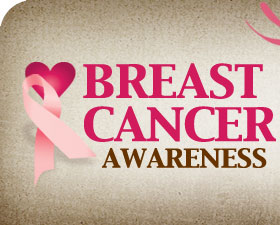The risk factors for breast cancer
Breast cancer affects hundreds of thousands of families each year. A potentially deadly disease, breast cancer is associated with several risk factors. Some of those risk factors, including gender and age, are beyond an individual's control, while other risk factors are associated with certain lifestyle choices. But even if a woman has the risk factors for breast cancer, that does not mean she will get the disease. In fact, a woman can several of the following risk factors and never get breast cancer, while other women can have just one of the risk factors and still get a breast cancer diagnosis.
Risk factors beyond your control
* Gender: Women are far more likely to develop breast cancer than men. The American Cancer says breast cancer is roughly 100 times more common among women than men. That's likely because men produce far less estrogen and progesterone, female hormones that can promote the growth of breast cancer cells.
* Age: An individual's risk for breast cancer increases as he or she ages. Roughly two-thirds of all invasive breast cancer cases are found in women over the age of 55, while just 13 percent of such cases are found in women younger than 45.
* Genetics: The ACS notes that roughly 5 to 10 percent of all breast cancer cases are believed to be hereditary. These cases result from mutations, or defects in a gene, inherited from a parent. In many cases a person will inherit a mutation in the BRCA1 and BRCA2 genes, which will normally prevent cancer by making proteins that keep the cells from growing abnormally. However, when these genes mutate, the risk for developing breast cancer is significant, as high as 80 percent for someone who has inherited mutated BRCA genes.
* Family history: Women with a blood relative who has had breast cancer are also at greater risk of developing the disease. If a first-degree relative, which includes a mother, sister or daughter, has had breast cancer, a woman's risk roughly doubles. Having two such relatives who have had breast cancer triples a woman's risk.
* Race and ethnicity: White women are slightly more likely to develop breast cancer than African-American women. However, African-American women are more likely to die from the disease. Asian, Hispanic and Native American women have a lower risk of developing and dying from breast cancer.
* Dense breast tissue: Women with dense breast tissue, which is noticeable on a mammogram, have a higher risk of breast cancer. But dense breast tissue can make it harder for physicians to detect potential problems on a mammogram.
* Menstrual cycles: Women who began menstruating prior to age 12 and/or went through menopause after age 55 have a slightly higher risk of breast cancer. Researchers believe this is because these women had a longer lifetime exposure to estrogen and progesterone.
Risk factors you can control
* Having children: Women who have never given birth or who gave birth for the first time after the age of 30 have a higher risk of developing breast cancer. Pregnancy reduces the total number of menstrual cycles a woman will have over her lifetime, which some feel is the reason that becoming pregnant can reduce a woman's risk.
* Oral contraceptive use: Women who have used oral contraceptives, often referred to as birth control pills, have a higher risk of breast cancer than women who have never used them. But that risk returns to normal when a woman stops taking birth control.
* Breastfeeding: Some research has linked breastfeeding with a slightly lower risk of developing breast cancer, especially among women who breastfeed for 11/2 to 2 years. However, breastfeeding for such a lengthy period is relatively uncommon, which has made the potential link between breastfeeding and a lower risk of breast cancer difficult to determine.
* Alcohol consumption: The ACS notes there is a clear connection between alcohol consumption and breast cancer risk. The more alcohol a woman consumes, the greater her risk for developing breast cancer. Women who consume two to five alcoholic beverages daily have roughly 11/2 times the risk of breast cancer as women who do not consume alcohol.
* Overweight and obesity: Women, especially those who are post-menopausal, who are overweight or obese have a greater risk of developing breast cancer. After menopause, most of a woman's estrogen comes from fat tissue, and a woman with more fat tissue will likely have higher estrogen levels, increasing her risk of breast cancer. Blood insulin levels also tend to be higher in overweight or obese individuals, and elevated blood insulin levels have been linked to some cancers, including breast cancer.
* Physical activity: More and more evidence is piling up to suggest that exercise can reduce breast cancer risk. Studies vary as to how much exercise is necessary to reduce the risk, but the benefits of exercise are so numerous as to encourage women to be more physically active regardless of how much they may reduce their risk of developing breast cancer.



